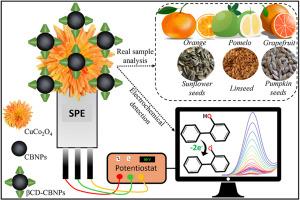利用β- cd -炭黑/CuCo2O4纳米复合材料电化学定量测定柑橘果实和油籽中的邻苯酚
IF 6.3
1区 农林科学
Q1 FOOD SCIENCE & TECHNOLOGY
引用次数: 0
摘要
有毒农药在全球的广泛使用构成了严重的风险,因此,准确量化食品样品中的农药残留量对于保障人类健康和确保遵守法规至关重要。在这项工作中,我们提出了一个灵敏的电化学平台,用于检测广泛使用的收获后杀菌剂邻苯酚(OPP)。为了精确检测食品中的OPP,我们评估了一种由β-环糊精/炭黑和钴酸铜纳米花纳米复合材料修饰的丝网印刷碳电极(βCD-CBNPs/CuCo2O4/SPE)的电化学性能。该电极在峰值电流和分析物浓度之间建立了很强的线性关系,检测限极低,为0.8 nM,灵敏度为6.55 μ a - μ m - 1cm - 2。该传感器还显示出卓越的选择性、可重复性、再现性和稳定性,突出了其在现实场景中的应用潜力。此外,该传感器在柑橘类水果(橙子、柚子、葡萄柚)和油籽(葵花籽、亚麻籽、南瓜籽)的测试中显示出较高的OPP回收率(96.73 - 100.60%)。本文章由计算机程序翻译,如有差异,请以英文原文为准。

Electrochemical quantification of O-phenylphenol in citrus fruits and oilseeds using β-CD-carbon black/CuCo2O4 nanocomposite
The widespread use of toxic pesticides around the globe poses critical risks and hence it is vital to accurately quantify its residues in food samples for safeguarding human health and ensure regulatory compliance. In this work, we proposed a sensitive electrochemical platform for detection of widely used post-harvest fungicide, O-phenylphenol (OPP). To precisely detect OPP in foods, we assessed electrochemical capabilities of a screen-printed carbon electrode modified with novel nanocomposite of β-cyclodextrin/carbon black and copper cobaltite nanoflowers (βCD-CBNPs/CuCo2O4/SPE). The proposed electrode established strong linear correlation between peak current and analyte concentration resulting in extremely low detection limit of 0.8 nM and sensitivity of 6.55 μAμM−1cm−2. The sensor also displayed exceptional selectivity, repeatability, reproducibility, and stability highlighting its potential for use in real-world scenarios. Furthermore, the sensor displayed high OPP recovery values (96.73–100.60 %) when tested with citrus fruits (orange, pomelo, grapefruit) and oilseeds (sunflower seeds, linseed, pumpkin seeds).
求助全文
通过发布文献求助,成功后即可免费获取论文全文。
去求助
来源期刊

Food Control
工程技术-食品科技
CiteScore
12.20
自引率
6.70%
发文量
758
审稿时长
33 days
期刊介绍:
Food Control is an international journal that provides essential information for those involved in food safety and process control.
Food Control covers the below areas that relate to food process control or to food safety of human foods:
• Microbial food safety and antimicrobial systems
• Mycotoxins
• Hazard analysis, HACCP and food safety objectives
• Risk assessment, including microbial and chemical hazards
• Quality assurance
• Good manufacturing practices
• Food process systems design and control
• Food Packaging technology and materials in contact with foods
• Rapid methods of analysis and detection, including sensor technology
• Codes of practice, legislation and international harmonization
• Consumer issues
• Education, training and research needs.
The scope of Food Control is comprehensive and includes original research papers, authoritative reviews, short communications, comment articles that report on new developments in food control, and position papers.
 求助内容:
求助内容: 应助结果提醒方式:
应助结果提醒方式:


